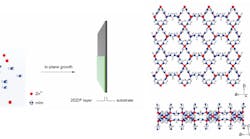Researchers based in Switzerland have developed a 2-nm thick metal-organic framework (MOF) structural unit, which they say yields record levels of hydrogen-nitrogen separation.
Led by Kumar Varoon Agrawal, associate professor and chair of advanced separations with the Institute of Chemical Sciences and Engineering at the École Polytechnique Fédérale de Lausanne (EPFL), Switzerland, the team worked with particular types of MOFs known as zeolitic imidazolate frameworks (ZIFs).
The chemical and physical properties of ZIFs have been widely explored; their intrinsic nanoporosity hint at important separation possibilities. However, further investigation has been hampered by the difficulty in creating films of less than 50 nm thickness.
So, the EPFL team developed an innovative crystallization method involving carefully controlling precursor interactions with the substrate. Within minutes, at room temperature, they were able to fabricate macroscopically uniform two-dimensional (2D) ZIF films one structural unit thick, made of a uniform array of hydrogen-sieving six-membered zinc-imidazolate coordination rings. They then prepared films with areas of hundreds of square centimeters.
As described in a recent issue of Nature Materials, when an equimolar H2:N2 mixture was probed with a feed pressure of 2 bar, an H2 permeance of 17,300 gas permeation units (GPU) with an H2:N2 separation factor of 115 was obtained, indicating negligible resistance from the 2D ZIF layer.
“This allows for an exceptional combination of hydrogen flux and selectivity, holding immense potential for highly efficient gas-separation applications,” explained Agrawal.
He added that the work is a proof-of-concept for synthesizing high-quality MOF films for membrane applications.
“We demonstrated 2D film for one MOF called ZIF. However, this method is applicable to many MOFs, which will allow synthesis of 2D film of several topologies hosting a wide range of pore aperture and functionalities for various kinds of separation such as gas, water, solvents, ions, and more,” he added.
His group also plans to expand this work to other families of ZIF that have been prepared with different combinations of metal and linkers — an example of which is described in the paper.
Another target is simplifying the membrane preparation process. “This requires depositing 2D MOF directly on easy-to-scale, low-cost porous support. We have identified such supports and are investigating deposition of 2D MOF on these,” Agrawal explained.
“The project that funded this work was the European Research Council Starting Grant, which supports high-risk, high-gain projects. Having demonstrated that the technology is feasible, we now hope to receive investment for further scale-up,” he concluded.

